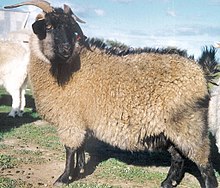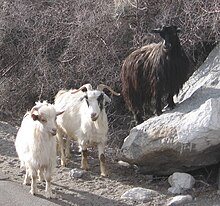31:
309:. The development of the breed started in 1980. By 1994, the breed had 372 nucleus herds and 681 selection herds. The bucks have thick, long horns and 85% of the does are horned. Ninety eight percent of the herd is white. The developers of the breed claim the lustre of the fleece is better than the Liaoning goat. The average production of a Wuzhumuqin adult does in 1994 was 285 g at 15.6 μm diameter; the average down length was 46 mm.
350:
111:
167:. They are raised for cashmere production and used as pack animals. The breed is most often white, but black, gray and brown animals also occur. They have large, twisting horns. This bloodline produces the finest Cashmere with an average diameter between 12-13 μm and average fiber length between 55-60mm. It is very rare and constitutes less than 0.1% of global cashmere production.
50:, the goat's fine, soft, downy, winter undercoat, in commercial quality and quantity. This undercoat grows as the days get shorter and is associated with an outer coat of coarse hair, which is present all the year and is called guard hair. Most common goat breeds, including dairy goats, grow this two-coated fleece.
321:
is the only entirely white breed of cashmere goat in
Mongolia recognized by the Mongolian Wool & Cashmere Association, found in the southwest region of the Gobi Desert, where it has adapted well to Gobi desert nomadic herding. The average cashmere production for males is 380 grams; adult female
207:
cashmere goat is a local dual-purpose breed with a long history. It adapts well to desert and semidesert pastures. The goats can be divided into five strains, Alasan (Alashanzuoqi), Arbus, Erlangshan, Hanshan and
Wuzhumuqin. The first three strains produce quality cashmere; the last two have been
97:
was taken from northern and western
Australia from the local bush goat population in the late 1970s. The production varies from herd to herd, with the most productive herds averaging 250 grams at a diameter of 15 μm. There is a breed and fleece standard, and active development of the breed
60:
In 1994, China had an estimated population of 123 million goats and is the largest producer of cashmere down. Local breeds are dominant. In the past decades, breeding programs have been started to develop productive breeds. The cashmere goat is a fiber goat along with the
577:
318:
232:
in 1984. By 1994, selected
Liaoning does were producing 326 g of down at 15 μm diameter. The selection work emphasizes size, length of body, quantity and quality of cashmere, the ability to climb, sturdiness, conformation and growth.
212:, with an average down diameter between 14.3 and 15.8 μm. The cashmere length is between 41 and 47 mm. In 1994, the total Inner Mongolian goat population was approximately 2.3 million goats.
297:. The Tibetan plateau goats are kept for down production. In 1994, an adult doe's average down production was 197 g, while the average adult buck's down production was 261 g.
224:
Province. The herd has been continually developed since then, and used to improve the cashmere herd throughout China. The
Liaoning goat is mainly found in the Buyun mountains in the
338:
in
Ningxia and Gansu Provinces in China, and are famous for their kid fur and cashmere production. The average fiber production for does is 216 g at 15 μm diameter.
306:
519:
610:
245:
Province, China. The down is usually brown, but the color can vary. The average doe down yield is 115 g at 14 μm diameter.
446:
Pattie, W.A.; Restall, B.J. (1989). "The inheritance of cashmere in
Australian goats. 2. genetic parameters and breeding values".
473:
595:
386:
229:
99:
17:
270:
94:
274:
605:
363:
220:
Breeding animals were selected in the 1960s from six counties in the eastern mountain area of
305:
This Inner
Mongolian strain is a new breed, recognized in 1994, and is distributed mainly in
600:
527:
8:
225:
459:
195:
provinces. A typical adult doe produces 184 grams of down at 15.7 μm diameter.
455:
477:
549:
355:
266:
183:, China. About 60% of the goats are white. The Hexi cashmere can be found in the
204:
180:
589:
331:
176:
54:
47:
390:
265:
In 1994, there were more than 7 million
Tibetan Plateau and Valley goats in
80:
region with the word "cashmere" deriving from an anglicisation of
Kashmir.
498:
30:
566:
128:
122:
70:
66:
62:
76:
The goats take their name from their origin in the Himalayan region of
254:
349:
335:
221:
208:
developed for high production. The average down yield is about 240
160:
144:
132:
433:
VI International Conference On Goats 6-11 May 1996 Beijing, China
322:
is 290 grams with fibers averaging 16.0-16.5 microns in diameter
282:
278:
228:. The breed was formally named the Liaoning cashmere goat by the
192:
188:
148:
110:
77:
524:
Government of Jammu & Kashmir, Animal Husbandary Department
242:
152:
115:
105:
294:
290:
286:
184:
164:
156:
140:
136:
209:
43:
567:
Goat cashmere | Mongolian Wool & Cashmere Association
476:. Australian Cashmere Growers Association. Archived from
389:. Australian Cashmere Growers Association. Archived from
241:
The Licheng Daqing goat is a dual-purpose breed from the
179:
has a long history in desert and semidesert regions of
257:
area; it produces a small quantity of dark soft down.
474:"ACGA Australian Cashmere Breed and Fleece Standard"
345:
334:
originated in the semidesert and desert area around
289:. There are also a small number of Tibetan goats in
277:, 1 million in Tibetan Autonomous Prefectures in
587:
198:
445:
27:Any breed of goat that produces cashmere wool
427:
106:Changthangi (Kashmir Pashmina) cashmere goat
83:
425:
423:
421:
419:
417:
415:
413:
411:
409:
407:
88:
57:, the guard hair by the primary follicles.
435:. International Academic Publishers. 1994.
325:
312:
215:
404:
109:
29:
260:
253:This dual-purpose goat is found in the
14:
588:
499:"Cashmere Group Sire Reference Scheme"
236:
381:
379:
248:
542:
102:running a sire referencing scheme.
24:
376:
53:The down is produced by secondary
25:
622:
520:"Kashmir Pashmina Technical Data"
501:. University of Western Australia
611:Goat breeds originating in India
348:
230:Chinese Ministry of Agriculture
100:University of Western Australia
571:
560:
512:
491:
466:
439:
13:
1:
369:
300:
93:The foundation stock for the
460:10.1016/0301-6226(89)90054-7
448:Livestock Production Science
199:Inner Mongolia cashmere goat
7:
596:Fiber-producing goat breeds
341:
34:An Australian cashmere goat
10:
627:
271:People's Republic of China
120:
84:Cashmere-producing breeds
578:Zalaa Jinst white strain
95:Australian Cashmere Goat
89:Australian cashmere goat
387:"Australian Goat Notes"
326:Zhongwei cashmere goats
275:Tibet Autonomous Region
273:. Five million were in
170:
364:William Windsor (goat)
319:Zalaa Jinst White goat
313:Zalaa Jinst White goat
216:Liaoning cashmere goat
118:
35:
285:and about 100,000 in
113:
33:
281:, half a million in
261:Tibetan Plateau goat
237:Licheng Daqing goat
98:continues with the
249:Luliang black goat
226:Liaodong Peninsula
119:
36:
530:on 4 January 2018
135:goat is found in
16:(Redirected from
618:
580:
575:
569:
564:
558:
557:
550:"Untitled Prezi"
546:
540:
539:
537:
535:
526:. Archived from
516:
510:
509:
507:
506:
495:
489:
488:
486:
485:
470:
464:
463:
443:
437:
436:
429:
402:
401:
399:
398:
383:
358:
353:
352:
114:Pashmina goats,
21:
626:
625:
621:
620:
619:
617:
616:
615:
586:
585:
584:
583:
576:
572:
565:
561:
548:
547:
543:
533:
531:
518:
517:
513:
504:
502:
497:
496:
492:
483:
481:
472:
471:
467:
444:
440:
431:
430:
405:
396:
394:
385:
384:
377:
372:
356:Cheshire portal
354:
347:
344:
328:
315:
303:
267:Tibetan Plateau
263:
251:
239:
218:
201:
173:
125:
108:
91:
86:
28:
23:
22:
15:
12:
11:
5:
624:
614:
613:
608:
603:
598:
582:
581:
570:
559:
541:
511:
490:
465:
454:(3): 251–161.
438:
403:
374:
373:
371:
368:
367:
366:
360:
359:
343:
340:
327:
324:
314:
311:
307:Xilingele Meng
302:
299:
262:
259:
250:
247:
238:
235:
217:
214:
205:Inner Mongolia
200:
197:
181:Gansu Province
172:
169:
121:Main article:
116:Ladakh (India)
107:
104:
90:
87:
85:
82:
46:that produces
26:
18:Cashmere goats
9:
6:
4:
3:
2:
623:
612:
609:
607:
606:Cashmere wool
604:
602:
599:
597:
594:
593:
591:
579:
574:
568:
563:
555:
551:
545:
529:
525:
521:
515:
500:
494:
480:on 2018-08-15
479:
475:
469:
461:
457:
453:
449:
442:
434:
428:
426:
424:
422:
420:
418:
416:
414:
412:
410:
408:
393:on 2018-07-21
392:
388:
382:
380:
375:
365:
362:
361:
357:
351:
346:
339:
337:
333:
332:Zhongwei goat
323:
320:
310:
308:
298:
296:
292:
288:
284:
280:
276:
272:
268:
258:
256:
246:
244:
234:
231:
227:
223:
213:
211:
206:
196:
194:
190:
186:
182:
178:
177:Hexi Cashmere
168:
166:
162:
158:
154:
150:
146:
142:
138:
134:
130:
124:
117:
112:
103:
101:
96:
81:
79:
74:
72:
68:
64:
58:
56:
51:
49:
48:cashmere wool
45:
42:is a type of
41:
40:cashmere goat
32:
19:
573:
562:
553:
544:
532:. Retrieved
528:the original
523:
514:
503:. Retrieved
493:
482:. Retrieved
478:the original
468:
451:
447:
441:
432:
395:. Retrieved
391:the original
329:
316:
304:
264:
252:
240:
219:
202:
174:
126:
92:
75:
59:
52:
39:
37:
601:Goat breeds
269:regions of
129:Changthangi
123:Changthangi
71:Angora goat
67:Nigora goat
63:Pygora goat
590:Categories
505:2008-07-24
484:2008-07-24
397:2008-07-22
370:References
301:Wuzhumuqin
69:, and the
554:prezi.com
55:follicles
342:See also
336:Zhongwei
222:Liaoning
161:Pakistan
145:Mongolia
133:Pashmina
283:Qinghai
279:Sichuan
255:Lüliang
193:Ningxia
189:Qinghai
149:Myanmar
78:Kashmir
534:27 May
243:Shanxi
153:Bhutan
295:Nepal
291:India
287:Gansu
210:grams
185:Gansu
165:India
157:Nepal
141:Tibet
137:China
536:2015
330:The
317:The
293:and
203:The
191:and
175:The
171:Hexi
163:and
127:The
44:goat
456:doi
143:),
131:or
592::
552:.
522:.
452:21
450:.
406:^
378:^
187:,
159:,
155:,
151:,
147:,
73:.
65:,
38:A
556:.
538:.
508:.
487:.
462:.
458::
400:.
139:(
20:)
Text is available under the Creative Commons Attribution-ShareAlike License. Additional terms may apply.

